Codiaum: what it looks like, types and care

All growers are familiar with such a plant as croton, but few people know: in fact, what we have long been accustomed to consider croton is codiaum. Let us dwell in more detail on the features of this unusual flower, its distinctive characteristics and conditions in which it will fully grow, develop and delight its owners for many years.
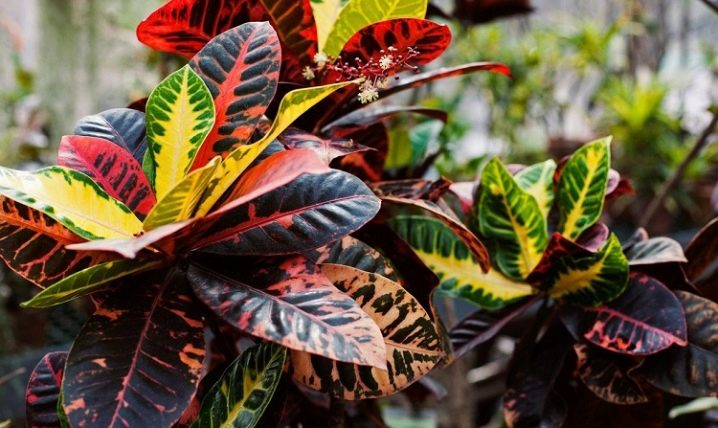
Description
Codiaum is a tall ornamental deciduous plant belonging to the Euphorbia family. In the people it is better known under the name "home oak". The use of this culture in home gardening is explained by the unusual appearance of incredibly beautiful leaves - they, as a rule, look very variegated and have a curly shape.
Domesticated varieties come from their wild "ancestors" that inhabit the rainforests of Indonesia, Oceania, India and Australia throughout. However, the area of living culture in nature is much wider. Today, certain varieties of codiaum can be found in many other parts of the world. For example, the dragon codiaum lives in America, and the laxative prefers Asian countries.
Thus, we can safely say that the progenitors of codiaums are scattered throughout the planet in those latitudes where natural and climatic conditions become comfortable for their full growth and development.
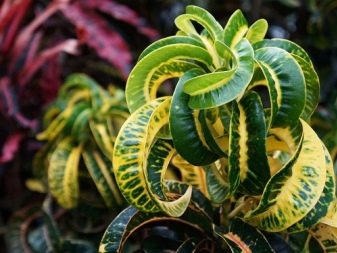
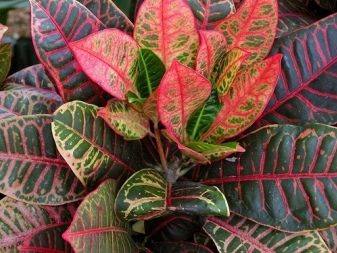
In the wild, the codiaum is represented by tall trees and shrubs, as well as herbaceous plants, outwardly they may appear a little gray - this is due to the fact that the leaf plates and stems are covered with hairs or small scales.
The leaves are quite large, solid, a unique variegated color is considered a distinctive feature - they are not only green, but also light green, as well as red, yellow, silver and even blue. In addition, the surface usually has many different spots, streaks and blots all over the surface, as well as pronounced textural veins.
Codiaum is considered a rather picky plant, therefore its content requires the grower to create the most comfortable living conditions. It must be borne in mind that, like the rest of the euphorbia, this flower contains milky juice, which is quite poisonous - upon contact with the skin and mucous membranes, it can cause irritation, as well as diarrhea and vomiting, up to Quincke's edema.
All work on the care of the codiaum should be carried out only with gloves, and after work, thoroughly wash your hands and all tools used.


Difference from Croton
Now let's dwell in more detail on why codiaum and croton are so often confused with each other, what are the similarities and differences between these two plants.
The main difference between codiaum and croton is that the former is more likely to belong to decorative deciduous crops, and the latter to wild-growing ones. It should be understood that codiaum is a domesticated relative of croton. Today, it is represented exclusively by indoor crops, which can grow and develop on windowsills without any problems. Croton, despite the similarity of botanical characteristics, is most often found in its natural habitat.

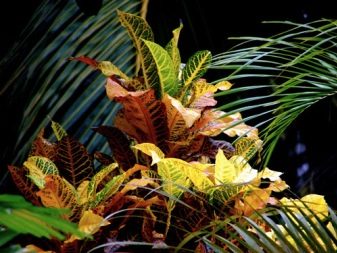
Although both plants belong to the same euphorbia family, they have certain differences - for example, crotons can be represented by both trees and shrubs, while codiaums are exclusively bushes.
And another difference is that codiaum performs only decorative functions in the interior and serves to decorate the room, while crotons can be used in some other ways. For example, some varieties are used in medicine, perfumery, tobacco blends and liqueurs.
Obviously, Croton and Codiaum are two completely different representatives of the flora, which some growers mistakenly identify with each other.
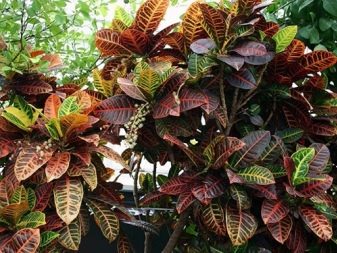

Types and popular varieties
To date, only one variety is mainly grown as a home plant - codiaum variegatum, as well as its many subspecies and all kinds of hybrid varieties, but they represent such a rich variety of bright colors and shapes that there is simply no need for other varieties.
Let us dwell on those cultures that are classified as the most popular types of codiaum in indoor gardening.
- Narrow-leaved - differs by elongated up to 20 cm and at the same time narrow (up to 1 cm) leaves of bright green color. On the outside of the leaf are scattered golden yellow specks and strokes.
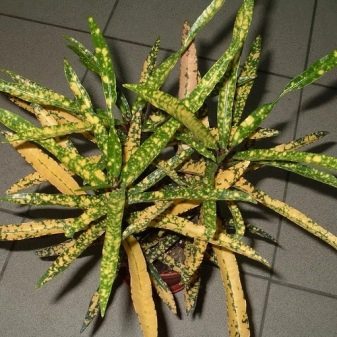

- Epididymis - it can be variegated or green, the leaf plates are expanded at the base, and in the center they narrow, forming a kind of waist, and then expand again, forming a kind of appendage at the edge of the sheet.
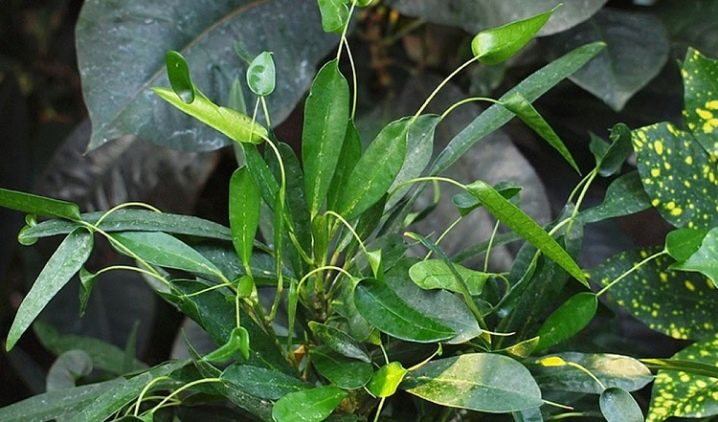
- Curly - differs in rather long, narrow and slightly curled leaves of green juicy color with pronounced spots and veins of a wide variety of yellow tones.

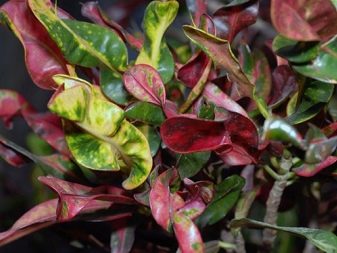
- Lobed - the leaves of this representative of codiaeum are rather wide and divided into three parts, while the central one is much wider than the lateral ones. Leaf plates of rich green color are decorated with bright blots.

- Flat-leaved - This pet has large leaves, reaching 25-30 cm, and the width is 10 cm. The shape is elongated, oval, the edges are wavy.
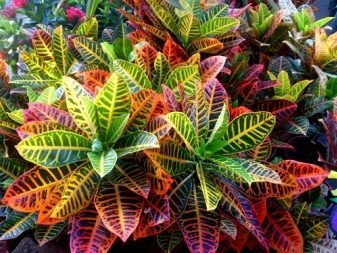
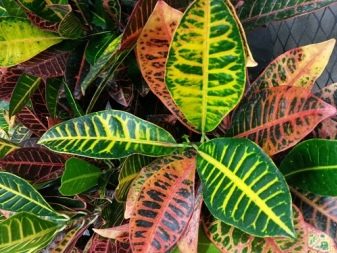
- Oval-leaved - characterized by rather simple oblong leaves with rounded edges. Numerous specks of rich golden hue can be seen near the textured veins.

- Tortoiseshell - leaf plates near the cutting are wide, but narrower closer to the edge. The leaves are olive green, along the central vein there are stripes and specks of light yellow shades.
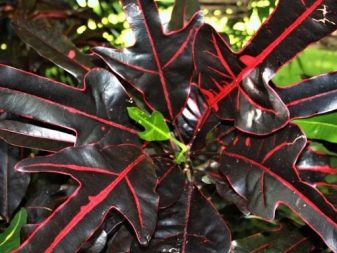
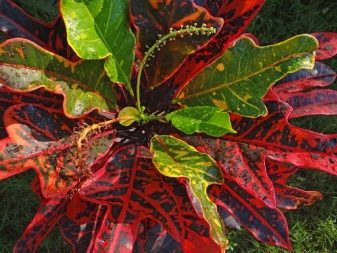
- Genuinna - for this variety, solid leaf plates of an elongated oval shape are typical, the color is green, with a pronounced pattern of a silvery or reddish-yellow hue.
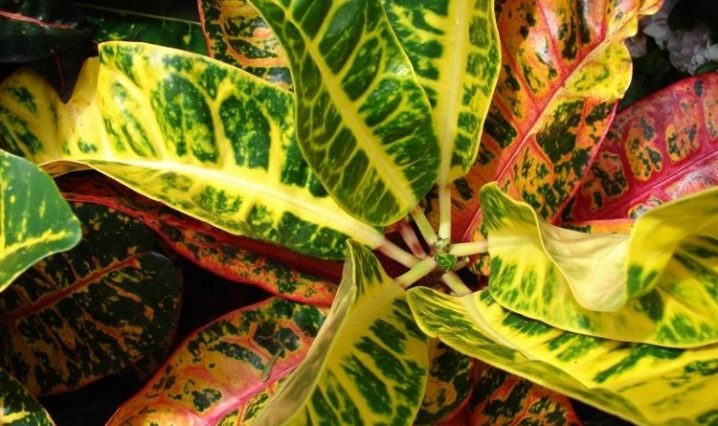
Codiaum variegatum is the mother form for a large number of hybrid varieties. The most famous codiaum is variegated. This is the most common indoor type of codiaums; it is precisely this type of flower that novice growers usually confuse with croton. Many other plants have been bred on the basis of the two crops.
- Croton Petra - home flower with glossy leaves of deep green color, they are characterized by alternating arrangement on the stem. The leaf plates are usually lobed or oval in shape, the color is green, the veins and tips are rich yellow. The stem is branching.

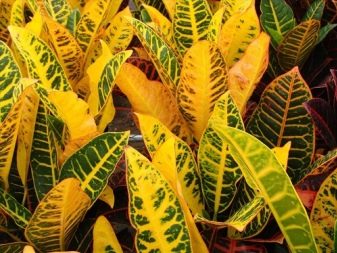
- "Mrs. Aiston" - this variety is distinguished by wide, but at the same time, short leaves with a rounded tip, the color is uneven. The color palette is very diverse - here you can find reds, pinks, as well as orange and yellow shades.
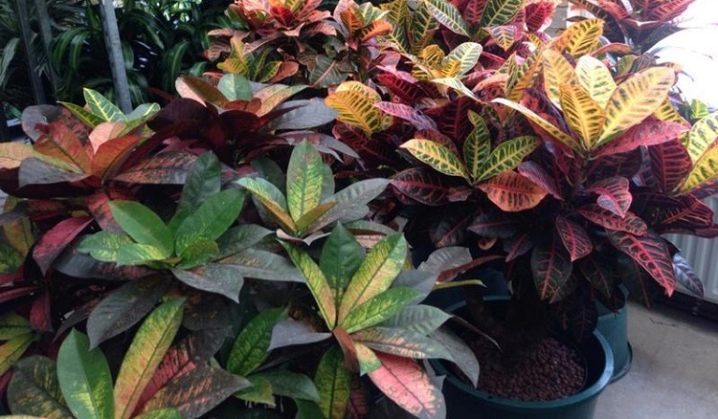
- "Norm" - a distinctive feature of this croton is considered to be leaf plates of a very bright emerald color with pronounced textured veins of a red hue and specks of gold.

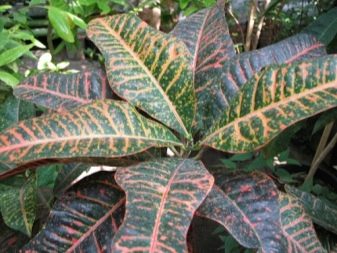
- Goldfinger - this variety has greenish-yellow leaves.

- "Excelent" - the leaves of this variety are similar to oak, they are quite large, dense.The upper side of the plate is light green, and the lower one has a pronounced crimson hue, the veins are textured, light yellow.

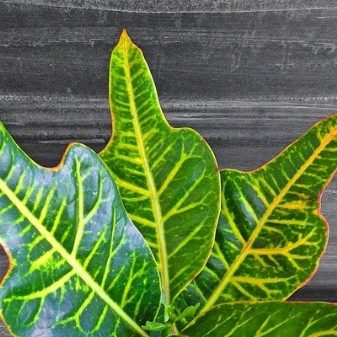
- Mummy - the leaves are reddish with chaotically spaced blotches of pink. The shape is wavy, twisted inward.
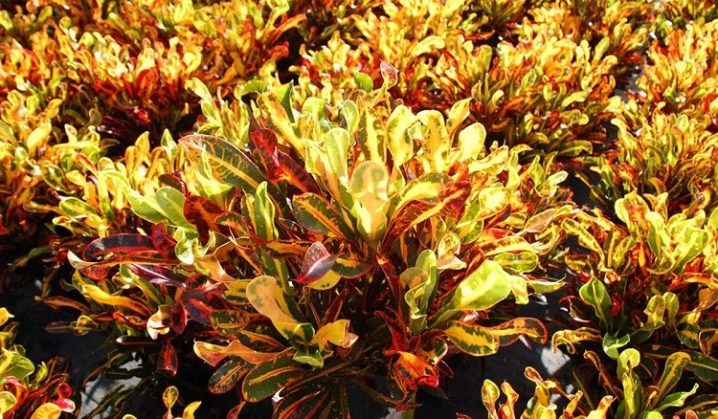
- "Gold Sun" - this variety has rather large oval leaf plates, light green color with pronounced yellow spots.
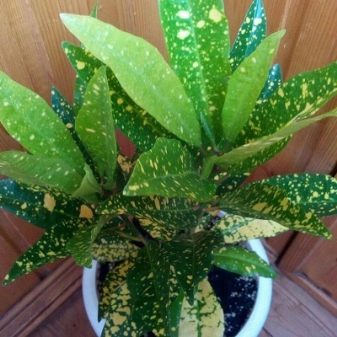
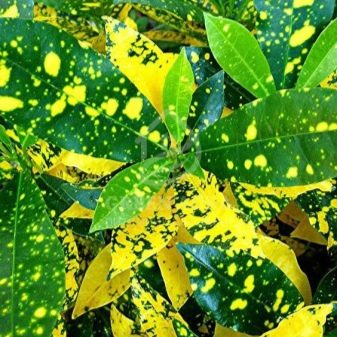
- "Zanzibar" - a very beautiful variety with long and thin, hanging down leaves of a wide variety of shades from yellow-green to crimson.
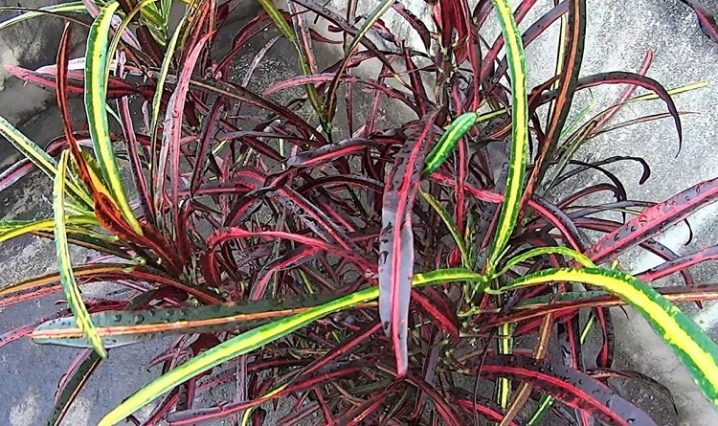
Aucubal codiaum, batik and varieties of "Tamara" "Golden Star".
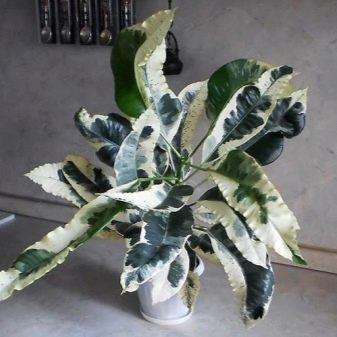

Landing
Codiaum grows well and develops only in loose, fertilized soil. It is advisable to use ready-made store-bought soil mixtures for decorative deciduous and flowering plants for planting. However, if you wish, you can always prepare the substrate yourself. The following combinations can be used:
- universal soil for indoor plants + substrate for orchids + charcoal;
- garden soil + peat + river sand;
- soil mixture from compost, as well as peat, with the addition of sand and garden soil.
For greater fertility, a spoonful of humus and a little sphagnum moss can be introduced into the soil to make it breathable.
Codiaums require good drainage, therefore, when arranging a container for planting, at least a third of the volume of the pot should be occupied by expanded clay or large pebbles - in this way, waterlogging is prevented.
Instead of expanded clay, you can also use foam, vermiculite or red brick chips.
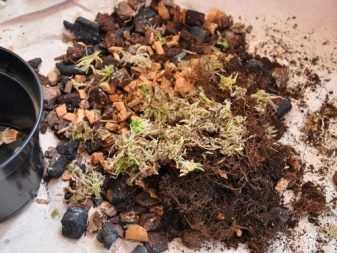
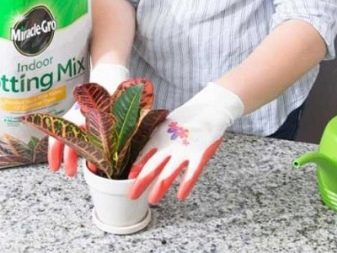
Before planting the plant, the prepared substrate should be disinfected, and the pot and drainage should be scalded with boiling water to destroy pathogenic microflora and eggs of insect pests. For the same purpose, several pieces of charcoal are added to the soil.
The planting capacity for codiaeum is taken of medium size, preferably shallow - this plant has a superficial root system and moisture stagnation may begin in the layers of soil mixture that have not been developed by roots, which has a most detrimental effect on the state of the green pet. The material from which the container is made does not matter, but it is better for a young flower to grow in plastic - it will be easier to transplant it as it grows... But for adult bushes, a container made of clay or ceramics is suitable - this is a heavy and stable material, it can withstand a rather massive crown of a flower and not fall.
In addition, ceramics has the ability to collect all the salts unnecessary for crotons and codiaums.
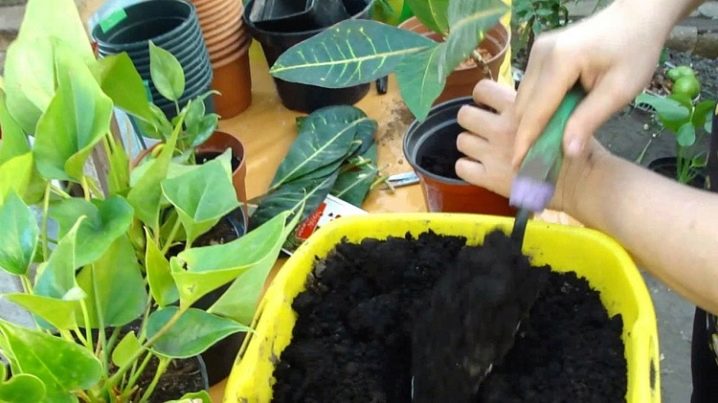
Care
Codiaum has never been a plant that is easy to cultivate, it has always had a reputation for being a very demanding and very capricious green pet. This exotic handsome man adapts to a change of residence for a very long time, immediately after transplanting it can get sick for a long time, needs good lighting and high humidity throughout the year. The flower does not tolerate low temperatures, cold drafts and dryness.
With the advent of home climatic equipment, it has become much easier to maintain a comfortable environment for plants. That's why flower owners should take care of buying an air humidifier, air conditioners and phytolampsthat will create conditions in the room close to natural. But even with such support, the codiaum requires constant attention, it needs to be properly looked after, protected from the movement of air currents, direct sunlight and temperature changes, it needs protection from pests, and also gratefully responds to periodic spraying of leaves, forming a bush and regular transplanting ...
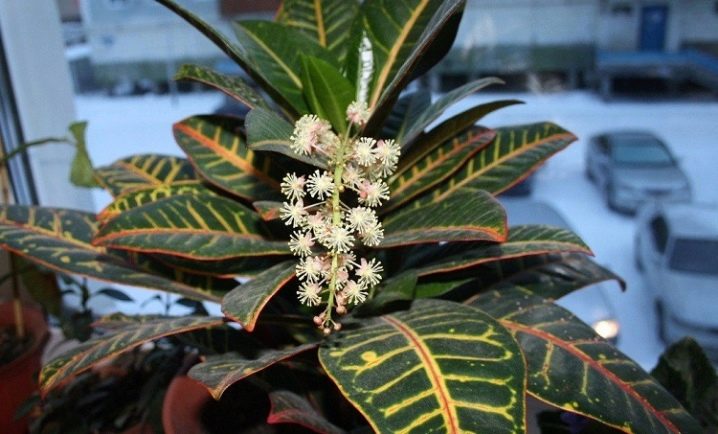
Temperature
In order for your contact flower to feel as comfortable as possible, it is required to maintain the optimal temperature regime at +20.24 degrees Celsius.The extremely low temperature for it is +23 degrees during the dormant period (from November to February), if it is cold in the room, then life processes begin to slow down, and the plant does not have the strength for full growth and development.
Temperatures above +24 degrees are also unfavorable for this ornamental shrub, but its harmful effects can be compensated for by increased parameters of air humidity.
Drafts should be completely excluded, as well as staying near heating devices - in both cases, the codiaum begins to stretch, the leaf plates wither, and soon the plant may die.
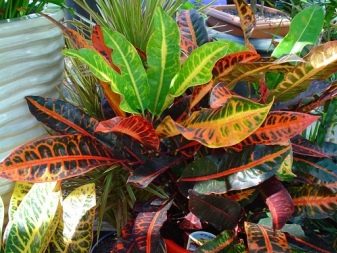
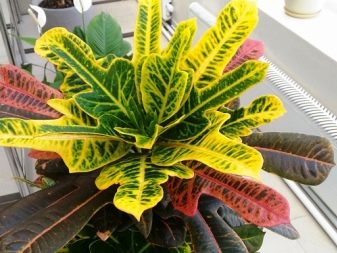
Humidity
Full care of the codiaum involves maintaining a given level of humidity. This figure should be 45% or more. If the air is too dry, you will have to apply a lot of effort to avoid yellowing and falling leaves, especially often this problem occurs in winter when the heating is turned on.
You can help a representative of tropical flora if from time to time you turn on the indoor fountain near the flower, lay out the pallet with moss and, of course, spray the leaves from a spray bottle. Such a shower will not only increase the humidity parameters around the codiaum, but also stabilize metabolic processes in plant tissues.
Keep in mind that when spraying, water should not hit the ground.
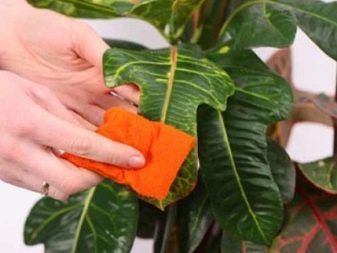
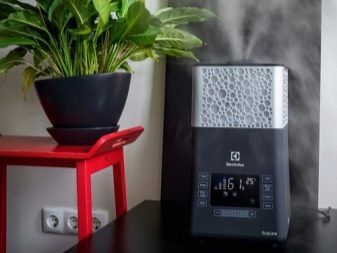
Lighting
Codiaum responds very well to long daylight hours, it prefers bright illuminated places, but the light must always be diffused - under the scorching sunlight, there is a high probability of burns on the leaf plates.
Precisely because the optimal directions for the arrangement of flowers are east and west... If the plant is grown on a southern windowsill, then it will need additional darkening. On the north side, the flower can fully develop only with the use of additional lighting, otherwise the shoots begin to stretch, the leaves lose their variegation and richness of colors, and then completely fall off. The plant begins to wither and soon dies.
Usually, special phytolamps are used for illumination - they have the required yellow glow spectrum and at the same time do not create an increase in temperature around the plant.
However, if there is no special lamp, then an ordinary fluorescent lamp can help, but in this case it should be located at a distance of 50-60 cm from the flower.
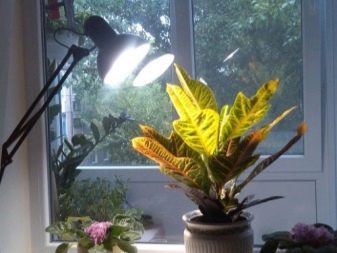

Watering
The main requirement for caring for codiaum comes down to good hydration from March to September. The plant needs abundant watering, which is done as the substrate dries up in the pot. In the cold season, the activity of the plant decreases, so it needs to be watered not so abundantly and irrigated a little less often - you can withstand a couple of days after the earth dries out.
The plant immediately signals a lack of water - the foliage becomes faded, loses its elasticity and wilts, however, excessive irrigation can also cause rotting of the roots, as a result, the aerial part of the flower does not receive enough nutrients and begins to dry and wither.
For irrigation, use soft water, preferably settled for 2-3 days or filtered.
A couple of times a week, the codiaum needs to arrange a warm shower or wipe the sheet plates with a soft, damp sponge.

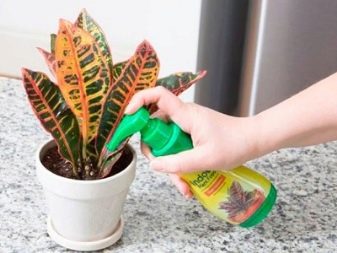
Fertilizer
In spring and summer, at the same time as watering, it is necessary to feed the flower. To do this, you can use ready-made complex preparations, enriched with all minerals, micro- and macroelements necessary for normal life of plants. Top dressing should be done every 2 weeks.
In the resting phase - in winter - fertilization can be paused.
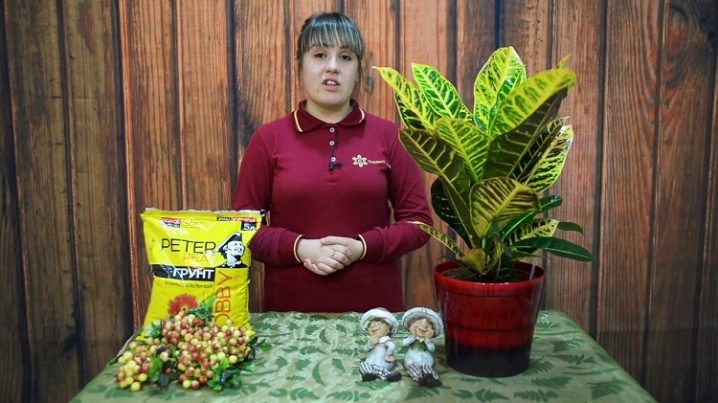
Molding
If you want your codiaum to have a beautiful crown, it must be pruned periodically; for a young plant, pruning is replaced by pinching.Cutting off the upper part of the shoots stimulates the growth of the lateral ones, so that the crown is dense and can be shaped to the desired shape.
As a rule, the buds and flowers of the codiaum do not have any decorative function, but only take on some of the vital nutrients and juices, they are recommended to be removed along with the leaves that have withered and lost their elasticity.
Pruning shears or sharp sterile scissors are used for trimming, and after the procedure, the cut site is sprinkled with crushed activated carbon.
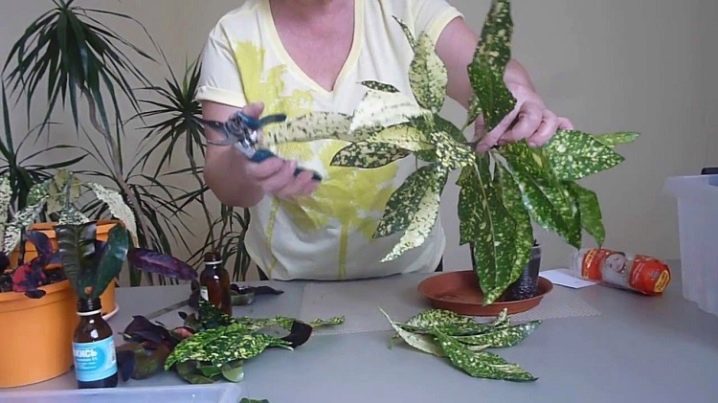
Reproduction methods
Indoor codiaum is propagated by seed or by cuttings.
Seed material must always be fresh. To begin with, the seeds are poured with warm water (50-60 degrees) for half an hour, then taken out and left to swell for a day, wrapped in a moistened napkin.
While the seeds are being prepared, they make up the soil mixture. It is important that it is drained, nutritious, slightly acidic, with high parameters of water and air permeability.
The seeds are buried in the substrate by 1 cm, watering is carried out in the lower way through the pallet until the first shoots appear. When the seedlings acquire 2-3 leaves, you can safely transplant the young plant into small separate pots.
Most often, the grafting method is used at home. To do this, a stalk 8-15 cm long is cut from the top, washed under running water so that all the milky juice comes out completely, and then dried under natural conditions for a couple of hours. After all the manipulations, the cutting is placed in warm water in order to root it.
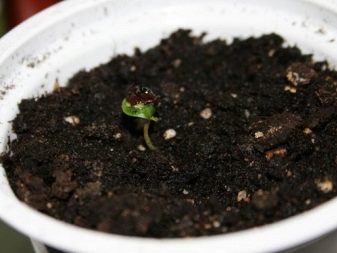
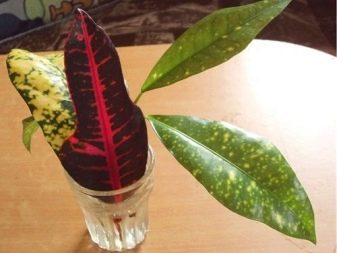
To avoid decay of the roots, you can add a little coal to the vessel, or you can tint the water with pharmacy blue. It is advisable to create greenhouse conditions in the container - cover it with plastic wrap or glass in order to maintain high humidity and the optimum temperature for germination at +25.28 degrees Celsius. To place the container, you should choose bright places, but such that they do not get direct sunlight.
Usually, rooting takes 2-3 weeks, as soon as the roots grow 2 cm, you can move the shoot to its permanent residence.
Experienced growers advise to propagate codiaum with leaves, for this they are cut into two parts, buried with cuttings in the ground and covered with a bag, periodically watering and sprinkling. After 2.5-3 months in a comfortable environment, the plant takes root and roots appear.
However, even in this case, it will not be possible to grow a full-fledged adult plant if there are no buds for escape, which is why, together with the leaf, it is imperative to cut off a small section of the stem.
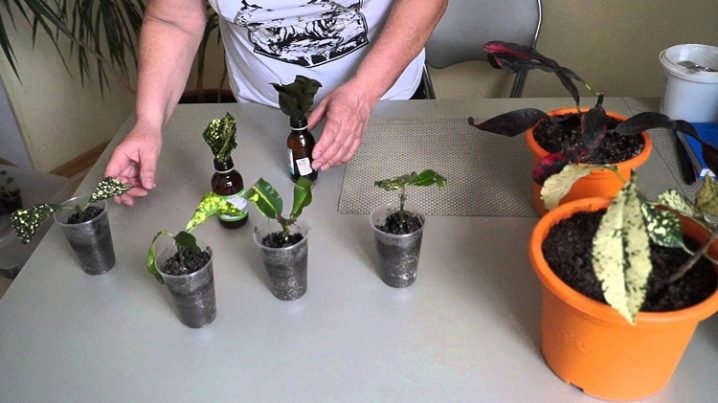
Transplant rules
As the codiaum grows, it must be transplanted into a larger pot. A young plant requires an annual container change, and an adult needs one transplant every 2-3 years. As a rule, the transplant is carried out in early spring, but if you notice that roots have emerged from the drainage holes, you can carry out work at any other time of the year.
Each new container should be 1.5-2 cm wider than the previous one.
Planting is carried out by the transshipment method - for this, the plant is well watered so that the earthy clod does not fall apart, and the roots remain intact, and then carefully removed from the substrate.
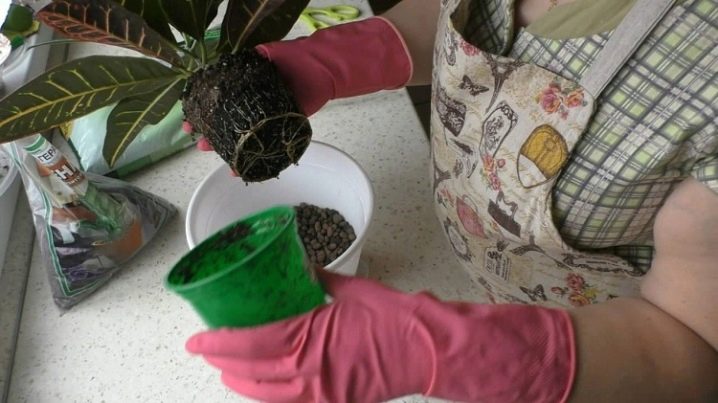
Before transplanting into a new pot, you should carefully examine the roots and remove all rotten fragments, then transfer to a new container and fill the voids with new soil, slightly compacting.
After transplanting, the plant is watered, sprayed and sent for adaptation to a warm, but shaded place, and placed on a permanent one only after 1.5-2 weeks. Keep in mind that codiaea very slowly get used to changing living conditions, therefore It is advisable to add rooting agents such as "Kornevin", "Epin" or "Ecoel" to the water for irrigation once a week. Epin solution, can also be used for spraying with a very fine spray bottle.
When the plant stops growing and is placed in a pot with a diameter of 25-30 cm, the transplant can be stopped - in the future, the annual renewal of the upper layer of the substrate will be enough, however, this must be done carefully, deepening no more than 5-7 cm.
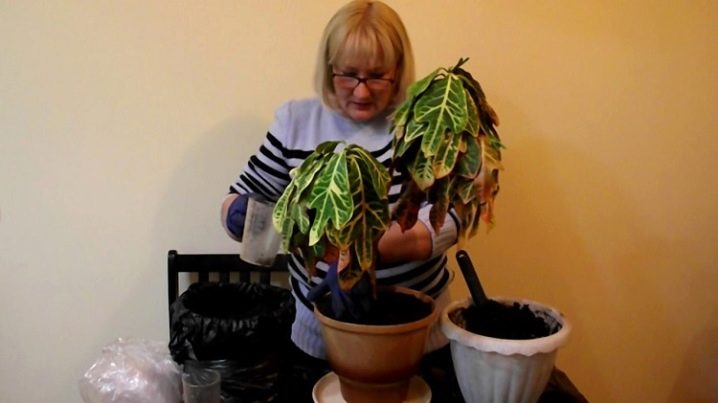
Flowering features
The flowering of codiaum is a fairly frequent phenomenon, monoecious flowers are small and faded, which in most cases combine into inflorescences.
However, in their beauty, the flowers cannot be compared with the variegated and bright foliage, they rather look like a small brush located in the leaf axils.
Flowers are divided into female and male, male flowers are similar to pom-pom circles and consist of stamens, female flowers contain curved pistils. Flowers of only one sex grow on each brush, the disclosure occurs at the same time. Usually, flowering greatly weakens the plant, suspending its development for 3-5 months, which is why at home flower growers are advised to remove peduncles after they appear - the plant will not lose its decorative effect, but it will develop more actively.
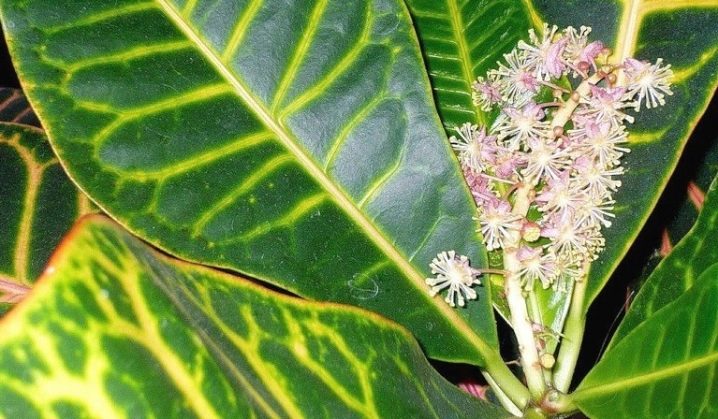
Diseases and pests
Violation of the care and maintenance of the plant often leads to a deterioration in the condition of your green pets.
When the tips of the leaf plates turn brown, this may be a sign of a lack of moisture or excessively dry air. To save the plant, the irrigation regime should be changed and the green mass should be regularly sprayed. It will also not hurt to install a container with water next to it or line the bottom of the pallet with moss to maintain an optimal level of air humidification.
The leaves fall and begin to fall - this happens with frequent temperature changes, also with insufficient moisture, the presence of drafts or too low a room temperature. If the codiaum is not moved to a warm place in a timely manner and irrigation is not established, the plant can die very quickly.
The appearance of a white fluffy bloom on leaf plates - occurs when using hard tap water for irrigation and spraying. To restore the attractiveness of the flower, the leaf plates should be treated with acidified water, and then sprayed with the settled liquid.

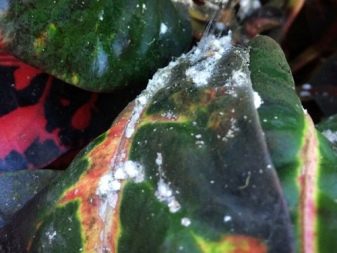
Loss of elasticity by leaves is the most common consequence of an excess of moisture, in this case, the plant should be transplanted, removing all rotten roots, and then watered only as the top layer of the earth dries up.
The leaves become faded, the stems stretch out - this is a sign of a lack of light. In this case, you need to transfer the codiaum to a more illuminated place, and if this is not possible, additional lighting will help.
The edges become thinner and brown - this clearly indicates that the plant is freezing. Make sure that the heating level in the room does not fall below +17 degrees.
Spots and blots on the leaves turn green - this directly indicates an excess of nitrogen in the top dressing.
You can save the plant if you change the fertilizer in a timely manner - it is better to choose complexes with a high potassium content.


If the codiaum has lowered and shed all its leaves, the plant can still be cured and its decorative effect restored. To do this, dilute "Epin" in warm water in accordance with the instructions and spray the bush abundantly, then wrap the flower with foil and leave in a warm shaded place for 10-14 hours.
During the recovery stage, the plant needs occasional watering, since moisture evaporates very slowly in the absence of foliage. When recovery does not occur, then the condition of the root system and trunk should be checked, if they are dry, further resuscitation is pointless.
Codiaeum often falls prey to attack by insect pests. If you notice that numerous brown plaques have appeared along the veins, it means that your pet is affected by the scabbard.The pest must be removed by hand; for this, the plates and stems of the plant are wiped with a sponge dipped in a concentrated solution of laundry soap, after which they arrange a warm shower for the flower and spray with insecticides.
The most effective in the fight against this parasite is "Actellik".


If the leaves began to turn yellow and wither, and a noticeable silvery cobweb appeared near the veins, there is a spider mite defeat. All diseased leaves must be removed and the crown treated with a systemic insecticide, usually Derris or Fitoverm is used. In the future, try to spray the plant as often as possible, since the mite does not tolerate high humidity.
If the plant dries quickly, the leaves droop and fall off - most likely, root rot takes place. In the early stages, it is successfully treated; for this, the plant is transplanted into new soil with the obligatory replacement of the pot. During transplantation, all damaged areas of the roots must be removed and sprinkled with crushed coal.
In the future, do not allow waterlogging of the soil; when changing the substrate, be sure to calcine the soil mixture.
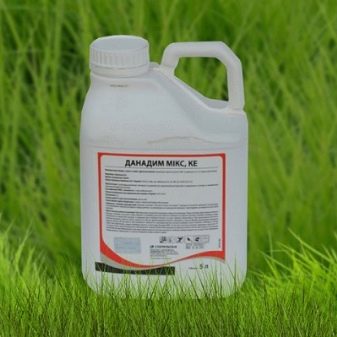

You can find out useful tips for caring for the codiaem by watching the video below.


























The comment was sent successfully.